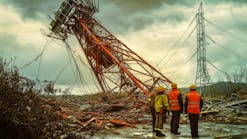In honor of Veterans Day: A look at the Military in Energy Transition
“Veterans know better than anyone else the price of freedom, for they’ve suffered the scars of war. We can offer them no better tribute than to protect what they have won for us.”
- - -
Ronald Reagan spoke these words nearly 40 years ago in a tribute during his radio address. And so in 2022 we once again mark Veterans Day and highlight the men and women who wore the uniform and took the oath to defend the United States.
In honor of Veterans Day, EnergyTech is reposting several stories about the military commitment to decarbonization which has occurred over much of 2022 and earlier. This is hardly worthy in tribute, but one small way we can highlight the military today.
And many veterans left the military to work in the power industry, whether for utilities or OEMs or suppliers, construction firms and as electricians, engineers and leaders. Those who defended our nation also helped build our grid and now our microgrids.
So here's a short look at how the military is marching toward cleaner energy goals.
- - -
In October, Marine Corps Base Camp Lejeune announced a $22 million contract for Duke Energy to build a microgrid at the installation in Jacksonville, North Carolina. The microgrid will be installed to support the critical education and training facilities at Camp Johnson, home to the Marine Corps Combat Service Support Schools at MCB Camp Lejeune.
This summer, Ameresco revealed its contract to build renewable, microgrid and energy effciency upgrades at the White Sands Missile Range in New Mexico. The microgrid system will include a 700-kW solar photovoltaic array, a 500-kW natural gas generator and a 500-kW battery energy storage system. This system will be designed to provide 14 days of power to the base’s potable water wells when there is a power outage.
In August, Missouri Army base Fort Leonard Wood detailed its installation of electric vehicle charging stations as its revamps its fleet. The training base also is gaining two new combined heat and power plants on site.
In January, the U.S. Air Force announced a strategic partnership, estimated at three years and valued at $60 million, with passenger airline firm Boom Supersonic, to acelerate research and development on flying a commercial jet fueled by sustainable aviation fuel.
One of the biggest military stories energy-wise, in terms of scope, was also posted in January when the Army Climate Strategy Plan was released. The goal outlined in the strategy was to reduce the Army’s net greenhouse gas emissions 50 percent by 2030 (over 2005 levels) and net-zero by 2050.
Among the actions to achieve those goals include installation of a clean energy microgrid at every installation by 2035. This mission ultimately will extend to achieving on-site carbon-free power generation for critical missions at installations only five years later.
Late in 2021, EnergyTech reported that the U.S. Department of the Navy and California Energy Commission were going to collaborate on microgrids and other clean energy projects. The focus would be on energy and water-related projects to improve the reliability, efficiency and resilience of Navy installations in California.
Ultimately, the goal of this review was not so much to highlight the military’s progressive approach to the energy transition--although that is significant--but simply a professional and editorial way to honor veterans and their families for their sacrifices to our nation’s defense. EnergyTech and Endeavor Business Media thank these soldiers, male and female, of every race and creed and color, for all the ways they fought to preserve the ideals which should always move us forward.
We owe our freedom to them alone, and to them and future generations also our commitment to making the world a better, cleaner and safer place.





